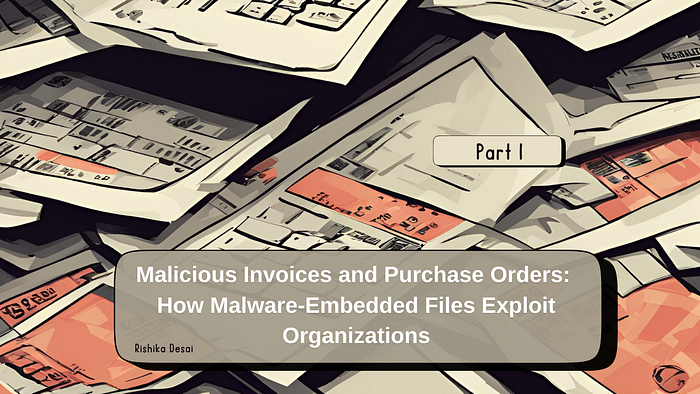You must have heard of many mitigation measures where articles suggest not downloading any PDFs and documents that land in your inbox from unknown sources. Ever wondered what happens?
A post on cybercrime forum highlights some methods why industries such as logistics, manufacturing, healthcare, and product-based businesses are often targeted by malicious phishing emails, since they capitalize on the trust and speed of business communications.
So here’s how malicious invoices and purchase orders exploit organizations and the attack process unfolds, from lead generation to system compromise.

Step 1: Targeting High-Privilege Individuals
To initiate the scam, the threat actor first gathers leads on high-privilege individuals within the targeted organization. The leads are provided from various aggregators, official websites, or purchased through data brokers operating on the dark web.
Individuals who are executives or staff members with access to critical systems, are primarily targeted because of their access privileges, while not necessary and limited to them, but are preferred for credential theft or malware attacks.
Step 2: Initial Communication and Industry Targeting
Once the threat actor has gathered the necessary leads, they initiate communication with their target organizations, posing as a legitimate vendor, partner, or client. Industries such as logistics, travel, manufacturing, healthcare, or product-based sectors are particularly vulnerable due to their heavy reliance on external vendors and their frequent handling of invoices and purchase orders.
The attacker’s communications, typically through email, often resemble standard business negotiations or vendor agreements. After an initial agreement is made, the threat actor sends a malicious invoice or purchase order, disguised as a standard attachment, such as a .doc, .pdf, or Excel file.
Step 3: The Attack Methods
There are two main methods used by cybercriminals to embed malware into these seemingly legitimate business documents:
Method A: Silent FUD Exploit in Document Attachments
In this method, the attacker sends an attachment — usually a .doc or .pdf file — designed as a “silent FUD (Fully Undetectable) exploit.” These files are typically embedded with botnet viruses or other malware that execute automatically when the file is opened.
The malware is capable of silently harvesting sensitive information such as:
- Passwords and login credentials
- Banking and cryptocurrency wallet details
- Session cookies and tokens
Once the malicious document is opened, the malware works stealthily, avoiding detection by traditional antivirus software due to its FuD coding. The threat actor requires expert coding skills to create a fresh exploit that is unique and difficult for detection systems to recognize. These exploits can remain dormant, gradually collecting valuable data from the compromised system over time.
Step 4: Credential Harvesting and System Compromise
Once either method succeeds, the attacker has multiple avenues for exploitation:
Method A: The credentials and sensitive information gathered through the malware allow the attacker to infiltrate additional systems, access financial accounts, or sell stolen data on underground markets.
Method B: Using the harvested login credentials, the attacker can perform account takeovers, accessing email accounts, cloud storage, and other sensitive resources.
Once inside, attackers can maintain persistence on the network, installing further backdoors or employing advanced techniques such as:
- Ransomware Deployment: Encrypting the company’s files and demanding ransom in exchange for decryption.
- Lateral Movement: Using the compromised account to spread malware across the organization’s network, escalating their level of access.
Step 5: Customized Malware and Social Engineering Templates
Beyond generic invoices and purchase orders, threat actors often go a step further by customizing their malware payloads and social engineering templates. These tailored attacks are designed to mimic an organization’s internal processes, making it even harder for employees to detect the scam.
By carefully crafting the malicious documents or phishing templates to reflect an organization’s workflow, attackers increase the likelihood that their scam will succeed. They may even use information gathered during the lead-generation phase to personalize the communication, giving it an air of legitimacy.

Figure: Step by step process describing how malicious invoices and purchase orders exploit organizations
Conclusion: Preventive Measures
Organizations can take several steps to protect themselves from malicious invoice and purchase order scams:
- Educate Employees: Conduct regular cybersecurity training, especially on phishing and malware techniques. Employees should be wary of unexpected invoice attachments or requests for login credentials.
- Verify All Transactions: Implement a verification process for all financial transactions. Encourage employees to cross-check payment or invoice details directly with vendors before proceeding.
- Use Multi-Factor Authentication (MFA): Enforce MFA for all high-privilege accounts, making it harder for attackers to exploit stolen credentials.
- Maintain Updated Security Systems: Ensure that antivirus software, firewalls, and intrusion detection systems are updated regularly to detect the latest threats.
- Monitor for Anomalies: Use security tools that monitor for suspicious activity such as account takeovers or data exfiltration.
By implementing these best practices, organizations can significantly reduce their exposure to malicious invoice and purchase order scams, ensuring that they remain one step ahead of cybercriminals.
I’ll include screenshots from a cybercriminal forum that mention this method and why I believe it’s important to explain the methodology in detail.
If you found this article helpful, please clap, like, and share!

